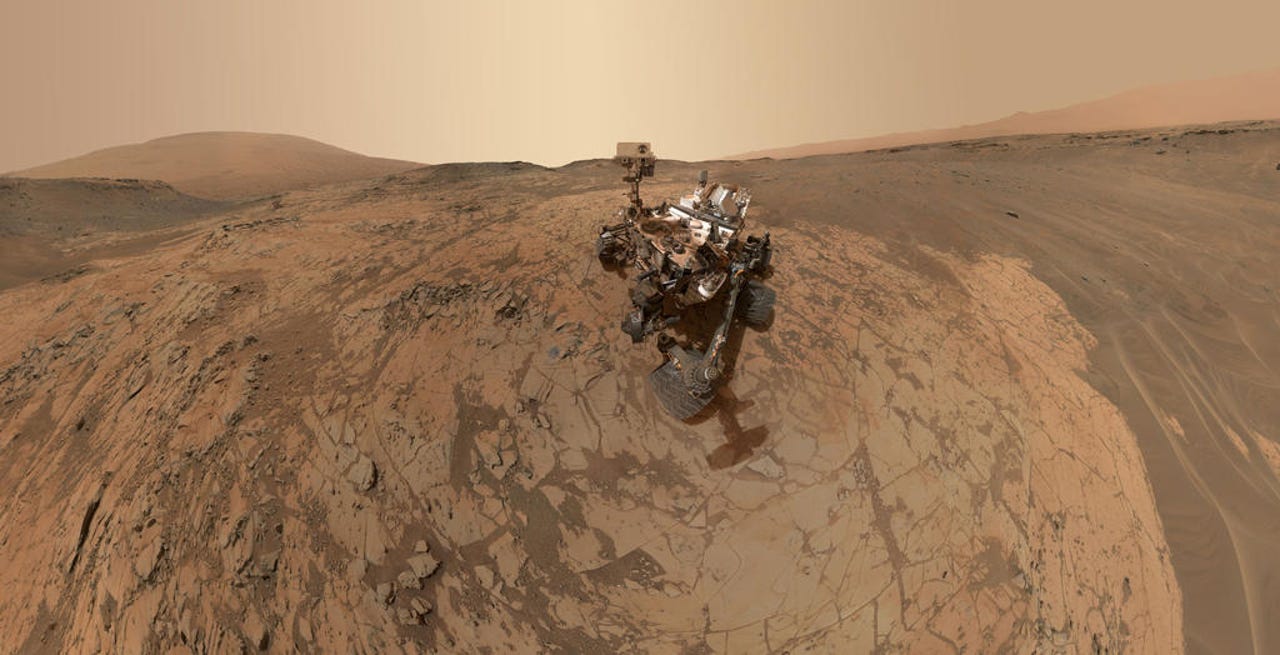































 Image: NASA/JPL-Caltech/MSSS
Image: NASA/JPL-Caltech/MSSS After 10 years of being on Mars, the Curiosity rover reached a long-awaited salty region of the planet. This region is vital to the exploration of the red planet because it could give scientists a better picture of what the climate on Mars was like before it dried up and became the frozen desert it is today.
The salty region refers to Mount Sharp, the "sulfate-bearing unit," that is enriched with salty minerals. "Scientists hypothesize that billions of years ago, streams and ponds left behind the minerals as the water dried up," NASA said Wednesday.
The minerals in this region could, therefore, give scientists clues as to how and why Mars' climate changed from being more Earth-like to what it is today.
These minerals were originally spotted by NASA's Mars Reconnaissance Orbiter years before Curiosity even landed on Mars and the rover's arrival in this region has, therefore, been eagerly expected.
While sharp rocks can damage Curiosity's wheels, sand can be just as big a risk, potentially causing the rover to get stuck if the wheels lose traction. Rover drivers need to carefully navigate these areas.
Also: NASA's Webb telescope takes dazzling images of the Pillars of Creation
Getting to the region proved difficult because of its treacherous terrain, including the sandy Paraitepuy Pass, which snakes between high hills that blocked the rover's view of the sky. That meant the rover had to be careful about where it could point its antennas towards Earth and how long it could communicate with orbiters overhead.
It took the rover over a month to navigate the terrain and reach its destination.
Once the rover arrived, it discovered an array of rock types and signs of past water, including popcorn-textured nodules and salty minerals, such as magnesium sulfate, calcium sulfate, and sodium chloride (ordinary table salt).
The rover captured panoramas of the scenery utilizing its Mast Camera, or Mastcam.
I have arrived!
- Curiosity Rover (@MarsCuriosity) October 19, 2022
After a trek through a sand-lined pass, I'm finally in a part of Mount Sharp enriched with salty minerals. I've already gotten a taste of this salty area, which scientists on my team believe may have formed as Mars' climate dried out. https://t.co/Y1yIUasZXt pic.twitter.com/pyyo7et3su
"We would get new images every morning and just be in awe," said Elena Amador-French of JPL, Curiosity's science operations coordinator. "The sand ridges were gorgeous. You see perfect little rover tracks on them. And the cliffs were beautiful -we got really close to the walls."
For the mission's 36th drill sample, NASA chose a rock nicknamed Canaima. Curiosity's seven-foot arm homes a percussive, rotary drill that pulverizes rock samples for analysis. Canaima proved to be the ideal rock to drill as other rocks were too hard for the drill to pulverize due to the worn breaks on the arm.
Curiosity captured this image of its 36th successful drill hole at a rock called Canaima on Mount Sharp using its Mast Camera.
Image: NASA/JPL-Caltech/MSSS"As we do before every drill, we brushed away the dust and then poked the top surface of Canaima with the drill. The lack of scratch marks or indentations was an indication that it may prove difficult to drill," said Curiosity's new project manager, Kathya Zamora-Garcia of NASA's Jet Propulsion Laboratory in Southern California.
"We paused to consider whether that posed any risk to our arm. With the new drilling algorithm, created to minimize the use of percussion, we felt comfortable collecting a sample of Canaima. As it turned out, no percussion was needed."
All 36 of the holes drilled by the Curiosity rover on Mars.
Image: NASA/JPL-Caltech/MSSSThe mission scientists are looking forward to studying the samples with the Chemical and Minerology instrument (CheMin) and the Sample Analysis at Mars instrument (SAM), according to NASA.
 Tags quentes :
Inovação
Espaço
Tags quentes :
Inovação
Espaço